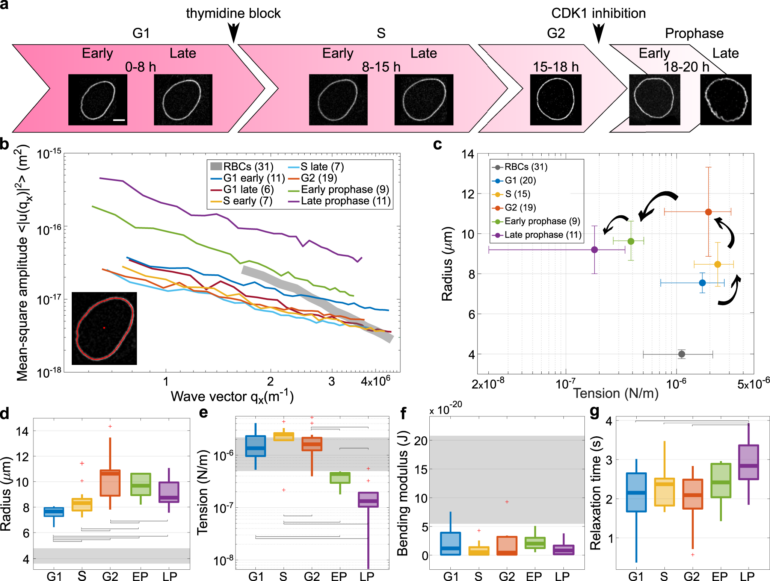Based on an experiment at CERN, a collaboration led by the Niels Bohr Institute, University of Copenhagen, can predict hitherto unchartered changes in the shape of nuclei.
The collaboration between the Niels Bohr Institute (NBI) and a theoretical group from Peking University has opened the door to new insights into the atomic nucleus from an unexpected point of view.
It turns out that the evolution of the most violent collisions between nuclei, as they are studied at the Large Hadron Collider at CERN, depends on the initial conditions, namely the geometry and shape of the colliding nuclei, which are in their ground state. More surprisingly, this insight also allows us to determine properties of the colliding nuclei that cannot easily be studied by other methods.
The researchers have predicted how the shape changes and fluctuations of the colliding nuclei will influence the outcome of extreme high-energy conditions. This paves the way for further studies which will yield a better understanding of the dynamic behavior of nuclei. An article on the results has been published in Physical Review Letters.
The predictions are theoretical but based on an experiment at the world’s leading physics research center, CERN, Switzerland.
“The research represents a significant step forward in understanding nuclear structure, shedding light on how the internal shapes of nuclei can transition,” says You Zhou, Associate Professor at NBI. He led the project, which was a collaboration between NBI and the group of Professor Huichao Song, Peking University, China.
Shaped like an American football
The nuclei of different atom species have different shapes, from round to oval. For their investigations, Zhou and his colleagues focused on Xenon, which has an oval form, resembling an American football.
Furthermore, Xenon is one of several atoms which may exhibit a variety of configurations—spherical, prolate, or oblate—and will alternate between these depending on the precise balance of the forces at play inside the atomic nucleus.
Such changes, known as nuclear shape transitions, are not only key to the stability of elements but also reveal deeper insight into the nature of strong interactions between protons and neutrons.
During an eight-hour experiment, Xenon atoms collided in the world’s most powerful particle accelerator, the Large Hadron Collider (LHC) at CERN. This accelerates the Xenon nuclei to near the speed of light.
As the nuclei collide with each other the temperature can be raised to about 5 trillion degrees Celsius, whereby the components of the nucleus c—protons and neutrons—are broken down into smaller constituents, quarks and gluons, forming so-called quark-gluon plasma, QGP for short.
A highly surprising finding
The extremely high temperatures can only be sustained for a very brief time. The conditions of interest exist for less than 10-24 seconds. This is much shorter than any measurement can handle.
“Therefore, we cannot follow the individual steps which result from colliding the atoms. We must look at the resulting products, and reconstruct the processes to match the findings,” explains Professor Jens Jørgen Gaardhøje, NBI.
It was the laborious work of interpreting the experimental data that provided the new insight, says You Zhou. “The resulting data could only be explained if we assume the Xenon nuclei to have an American football-like shape. This is consistent with what people learned in the past, but still surprising since the energy in this study is one million times higher than in earlier experiments.
“The general assumption has always been that the outcome of the collisions at very high energy would wash out any particular identity of the colliding nuclei and that the original geometry might not play a significant role for the resulting products.”
Perfect liquid filled the infant universe
As is often the case in fundamental research, the surprising result came as an added benefit. The main purpose of the high energy nuclear collisions experiment was not to investigate the nuclear shape transitions but rather to gain insight into the young universe. The extremely high temperature that can be obtained using the LHC corresponds to the conditions which existed just a millionth of a second after the Big Bang and before.
“According to our previous measurements at LHC, at this very high energy level the quark-gluon plasma is a liquid with very small viscosity. This is what we call a perfect liquid,” reports You Zhou, continuing, “The experiment was designed to investigate how the viscosity of the plasma changes, as the system evolves.”
Clever methodology made it possible
With 129 nucleons (54 protons and 75 neutrons), Xenon is a large atom. As two Xenon atoms collide head-on in the LHC, up to some 30,000 smaller particles—mainly quarks and gluons and their antiparticles—are formed. Calculating the properties and correlations of so many particles is impossible even with the best supercomputers.
“It was assumed that correlating three particles would be enough to probe the triaxial structure of Xenon. However, the results came out too crude, and we decided to extend the samples to six particles to examine whether Xenon has a fixed triaxial structure or its shape is changing,” says You Zhou.
Moving from three to six particles was no easy decision, since the amount of calculation grows exponentially with each added particle.
“Fortunately, we were able to develop an algorithm which allows us to do the calculations very efficiently. So, we can cope without the need for supercomputing. To our knowledge, we are one of the very few groups in the world able to do this. This opens, not only for much more sophisticated studies of the properties of the quark-gluon plasma, but also of the initial conditions and how these evolve during the expansion process,” notes Jens Jørgen Gaardhøje.
The group hopes to obtain time at LHC for a follow-up experiment in the summer of 2025.
More information:
Shujun Zhao et al, Exploring the Nuclear-Shape Phase Transition in Ultrarelativistic 129Xe+129Xe Collisions at the LHC, Physical Review Letters (2024). DOI: 10.1103/PhysRevLett.133.192301. On arXiv: DOI: 10.48550/arxiv.2403.07441
Provided by
University of Copenhagen
Citation:
Theoretical predictions provide a first peek at nuclear shape transitions (2024, November 11)



